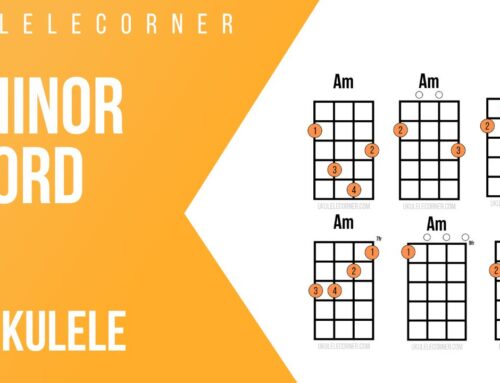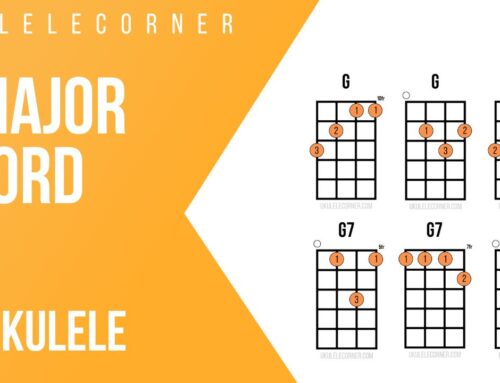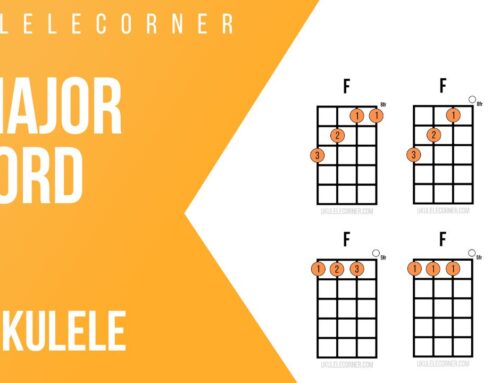Practice vs playing
Learning how to practice effectively on the ukulele takes time, discipline, and a bit of hard work. And that’s important to recognize: practice is not the same thing as playing. Practice is intensive labor—play is what you do when work is finished. And with that in mind we must be careful to separate out simply playing from disciplined practice. If you wish to make progress and improve on the ukulele, this is the best place to start.
How long should I practice?
One of the most frequent questions I’m asked about how to practice on ukulele is how long should I practice? While it’s a pretty straightforward question, the answer is not so simple. How long you should practice depends to an extent on how much time you have available, where you are on your ukulele journey (are you a beginner, or more advanced?), and how long you can stay focused. Obviously if you only have 30 minutes available to practice each day, then you’re limited to 30 minutes. However, even if you have three hours a day, should you practice all three hours? Here are some things to keep in mind.
If you’re a beginner, you may find it more difficult to practice for three hours at a time, and so making a practice routine that is manageable for you so you don’t feel overwhelmed is important. More advanced players, however, may find longer sessions to be beneficial because you can work on more at once. Nonetheless, even with a two- to three-hour practice routine it’s important to take breaks. Our minds can only stay focused for up to about 45 minutes before they start to wander. This issue may be more difficult for some rather than others so you’ll have to monitor how well you can focus and you may need to take frequent breaks to give your mind some rest. As you can see you may need to do some trial and error to see what works best for you.
But, what’s actually much more important than how long you practice is that you are consistent with your ukulele practice. Practicing 15 minutes every day will show much more tangible results than practicing for six hours every ten days.
Goals
How to set goals
To start, let’s set some goals. Goals are important for practice because they give you direction, something to shoot for, but also because they can help structure your practice time and keep you accountable. Here are a few key characteristics your goals should take:
- Be specific. If your goals are too vague or broad then it’s much easier to fudge on them and not follow through. So make sure your goals are specific and clear and you know exactly what you want to achieve.
- Make them achievable. If your goals are specific but too difficult to attain, you’ve made it too easy to give up down the line and, again, not follow through. So not only do your goals need to be specific but they also need to be something you can actually do.
- Check in on your goals regularly. If you don’t already keep a practice journal this would be a great time to start one. You can keep a physical journal or you can make one on your phone or computer, even online. Regardless, you want some way that allows you to monitor the progress you’re making with your goals so you can see how far you’ve come since you started, but also to adjust your goals if needed.
- Don’t be afraid to adjust your goals. While your goal might seem specific enough and achievable enough when you start out, you may notice somewhere down the line that you need to pare things down, or even make your goal more difficult to attain. Either way, sometimes we need to make changes. Don’t be so bound to the goals you’ve set that you can’t change them mid-stream.
Make your goals granular
With those principles in mind, start out by setting some long-term goals for your ukulele practice. Shoot for the moon here: What do I want to achieve in 5 or 10 years time? Remember to be specific and to make this something you feel like you can achieve (even if you need to slightly adjust it later). Great. Now set some medium-term goals: What do I want to achieve in 1 year? Here you can allow the longer-term goal to set the parameters for your medium-term goal. Then break those medium term goals down into some small-term goals. These can be one month, one week, or goals that you want to achieve each day in your practice . . . or even what goal you want to achieve with this one exercise in the next 15 minutes. The more granular you make your goals, breaking them down into smaller and smaller chunks, the easier they are to attain.
The great thing about having a tiered list of granular goals like this is they keep you moving forward, but not feeling overwhelmed by something unattainable and off in the future.
Warming up
Any form of physical exercise can be strenuous for the body and it’s important to warm up before you jump right in. Take running: some light stretching and even walking before you launch straight into running can prevent cramps and even injury. Practicing on ukulele is no different. Yes, we’re only moving the tiny muscles and tendons in our hands, but actually those tiny muscles and tendons are much easier to injure because they’re so tiny. Thus, we really need to take care of our bodies and warm up before we start our practice session in full. Remember: practice can be hard (physical) work, so be sure to ease into it gradually.
Stretches
To start out, do some simple hand and finger stretches. The important thing here is to be light: don’t pull or push with excessive tension and make sure you breathe in and out as you stretch (when you breathe the heart sends oxygenated blood to the muscles to help them stretch better). Rotate your hands at the wrist in circular motions in both directions; extend your arm and gently provide some counter-pressure to your extended hand with the other hand, first with fingers pointing up and again with fingers pointing down; touch each finger to the palm of your hand in both hands; stretch your neck and shoulder muscles. All of these can help get blood flowing to all those tiny muscles and tendons (and some of the bigger ones in the neck and shoulder, which are also very important).
Warmup exercises
Playing slow scales can be a great way to warm up because it involves both hands and requires coordination of both hands across the strings. It’s important when we’re playing warmup exercises that we’re not doing anything strenuous and so you don’t want to push yourself here. Don’t play fast. Intentionally take it very slow—almost like a meditation—and focus on relaxed, fluid motions of the fingers. Another great exercise is “Aldrine’s Spider,” a finger independence exercise created by the great ukulele player Aldrine Guerrero. Our good friend Craig Chee has a great video to help walk you through that exercise here.
Slow Practice
If you’ve ever worked with a teacher then you’ve probably heard this very common piece of advice: practice slowly. Slow practice is a tried and true way of practicing, but what makes it so effective?
Slow practice shines a magnifying glass on things that you need to correct, making it easier to identify problems and craft solutions so you can make progress. Oftentimes the tempo of what we’re working on can make us feel rushed and we might make a mistake but not really know what the problem was. We might even say, “Why did I make a mistake there? I never mess up there!” Slowing down removes that rushed feeling and allows us to see much more clearly things that are usually moving at too fast a pace for us to see. Thus, slow practice is an excellent diagnostic tool.
Moreover, at faster tempos we tend to tense up more (especially when we come to difficult spots in the music) and this can make a difficult passage even more challenging. With slow practice, though, it is much easier to stay relaxed. In fact, if you practice slowly enough you can be completely relaxed, almost meditative with how you approach a passage. This can sometimes be the key to making a difficult passage much, much easier. So, how should you practice? Slowly.
How slow?
But just how slowly should you practice? S L O W. No, I mean: S L O W. Don’t just slow down a little bit. It’s important that you take things at a snail’s pace. It’s a lot easier to see what’s going wrong and to stay relaxed if you slow down by at least half of your usual tempo. In fact, we can sometimes even remove tempo altogether and work just on the slowest mechanical motions possible to feel what it’s like to be relaxed in our motions. So the next time your teacher asks you to play slowly, make sure you really slow down!
Perfect Practice?
Another common adage about practice is that “practice makes perfect.” However, as we have been talking about already, how you practice is just as important as the fact that you practice. Practicing every day will not make perfect if you’re practicing in a way that contributes to the same problems day after day. Thus, many musicians corrected this phrase and began saying “perfect practice makes perfect.” This is a big improvement because it correctly suggests that how you practice actually affects the outcome. However, we have to be wary of “perfection.” As human beings, we make mistakes; we’re flawed, finite. We can’t expect perfection and no matter how “perfectly” you practice, perfection will still be just beyond your reach.
Classical guitarist Simon Powis recommends instead adopting a more “mindful practice.” He says, “If you are thoughtful, careful, aware, patient, and curious, in a word, mindful, then you will reach your full potential, quickly.” So, don’t shoot for perfection; instead, aim to be more mindful in your ukulele practice and you’ll see better progress.
Repertoire that’s too difficult
Finally, here’s a pitfall to avoid in your practice: Even if it’s very tempting to do so, try to avoid learning pieces or songs that are just too difficult for you. We are all at different stages on our ukulele journey, and it might be that you’re ready to tackle some virtuosic pieces or difficult jazzy chord progressions. Or it might be that you’re just starting out and those things are going to pull you away from the things you’re currently developing and make them much more harder to digest. There’s always time to work up your skills to get to those more difficult pieces. But if you try to shortcut that process you may find that it takes you longer to get there actually.
The real problem with playing things that are too difficult is that you are building up habits that will seep into everything else you’re learning. But it’s much more difficult to unlearn bad habits than it is to build up good habits from the start.
***
So how should you practice ukulele? Let’s recap:
- Practice, don’t play;
- Practice consistently (every day is better than six hours in one day);
- Set goals and make them achievable;
- Remember to warm up;
- Practice slowly;
- Practice mindfully;
- And don’t practice pieces that are too difficult.
Consistently, slowly, and mindfully. Set some goals, remember to warm up, and don’t shoot for things too far out of reach. Be happy with where you are on your ukulele journey, but always with a desire to keep making steady progress. Soon enough, if you take these tips into your ukulele practice you’ll reach all of your goals. Happy practicing!




I am so eternally grateful for this post. Very very educational and informative.
Glad you enjoyed it, Sam! Thanks for your comment and happy practicing!
Peace,
Dave B (UC team)
This is great. Encouraging. In the theme of the movie What About Bob?, baby steps. Or, mindful baby steps. Thank you.
This is great. Many teachers can model how to play a piece or provide other mechanical advice, but in my experience not so many teachers teach HOW to learn.
Thanks for the nice comment, Mike! We’re glad you enjoyed the article. Best wishes and happy practicing!
Peace,
Dave B (UC team)
This is a really helpful article, thank you so much. I have a baritone ukulele and would like to know if you are planning to publish a practice routines for fingerstyle baritone ukulele? I already have the excellent ukulele one, but a baritone version would be really helpful
Aloha Robert, We are planning on first publishing a Baritone method book that will include some concepts from the practice routine book.
thanks for the article – very encouraging.
Thank you for your wonderful piece on movable chords shapes. I’m so happy I found it! It’s nicely written, laid out, with photos, tables, index and all.
《《☆•~•☆•~•☆•~•☆•~•☆•~•☆•~☆》》
Thank you for your wonderful piece on movable chords shapes. I’m so happy I found it! It’s nicely written, laid out, with photos, tables, even an index!